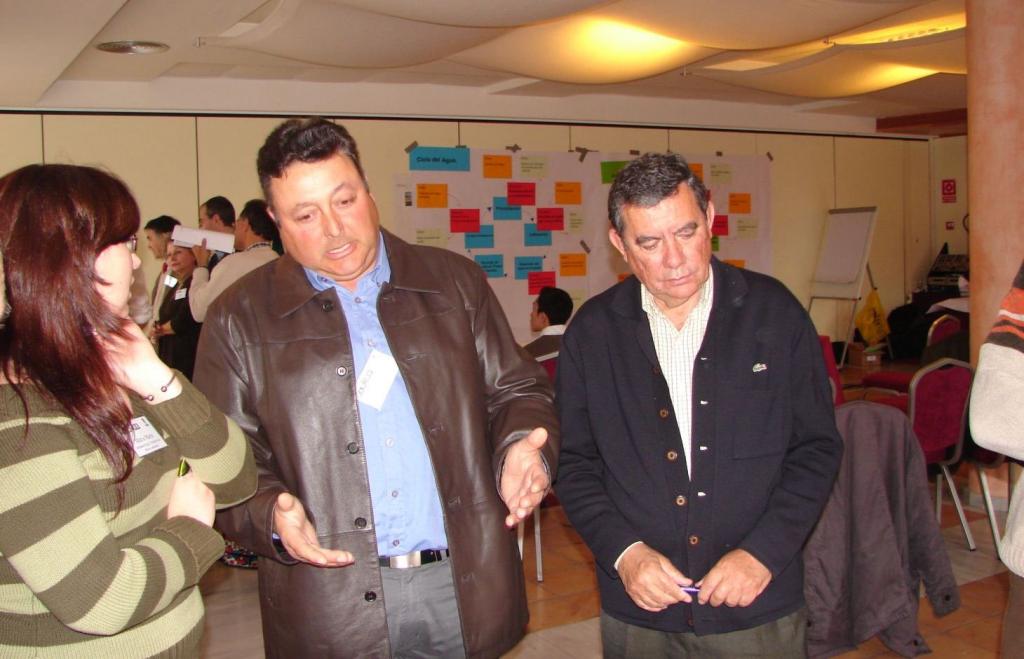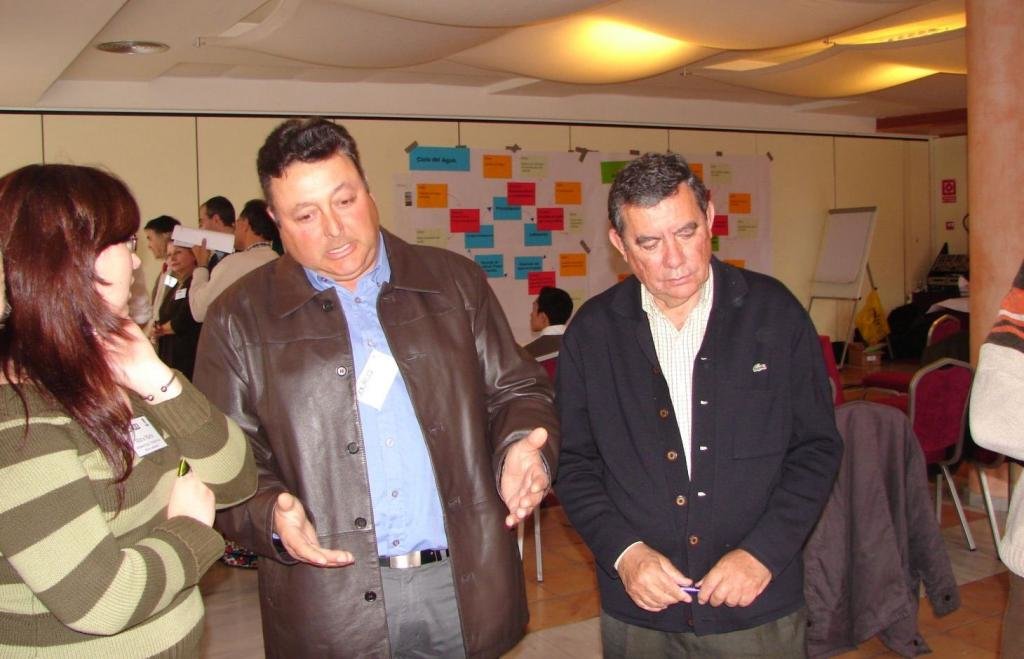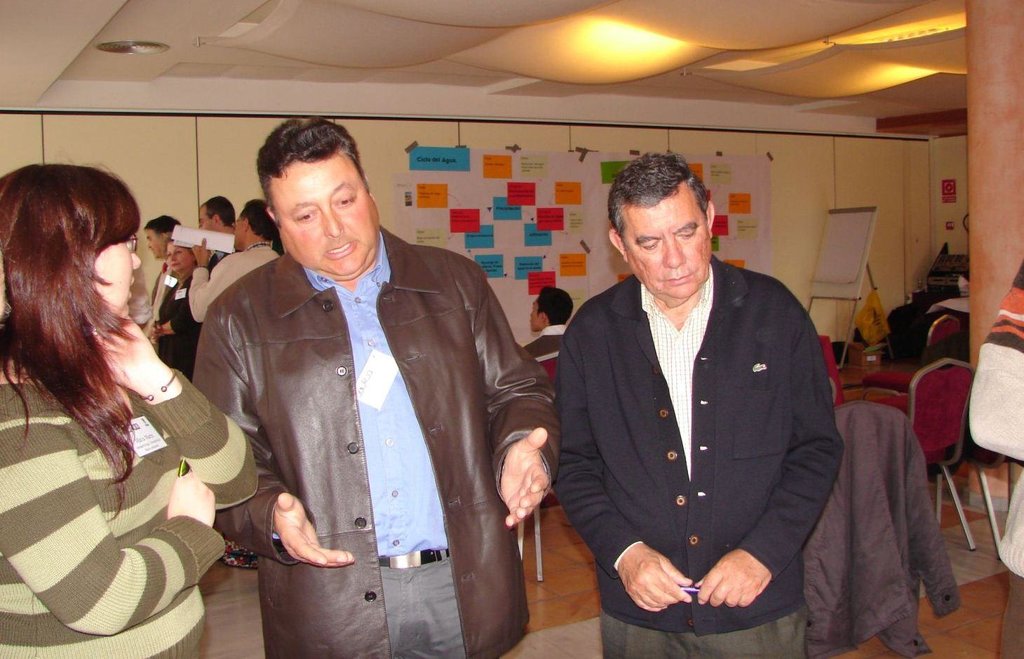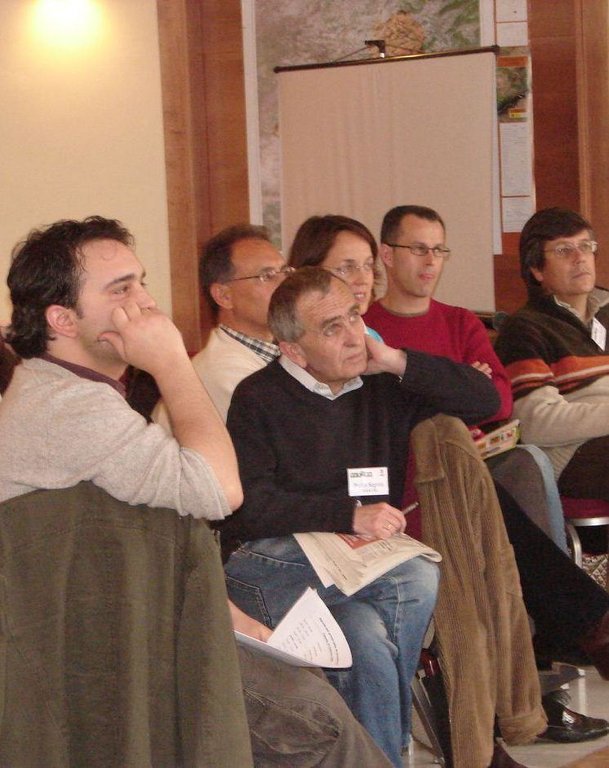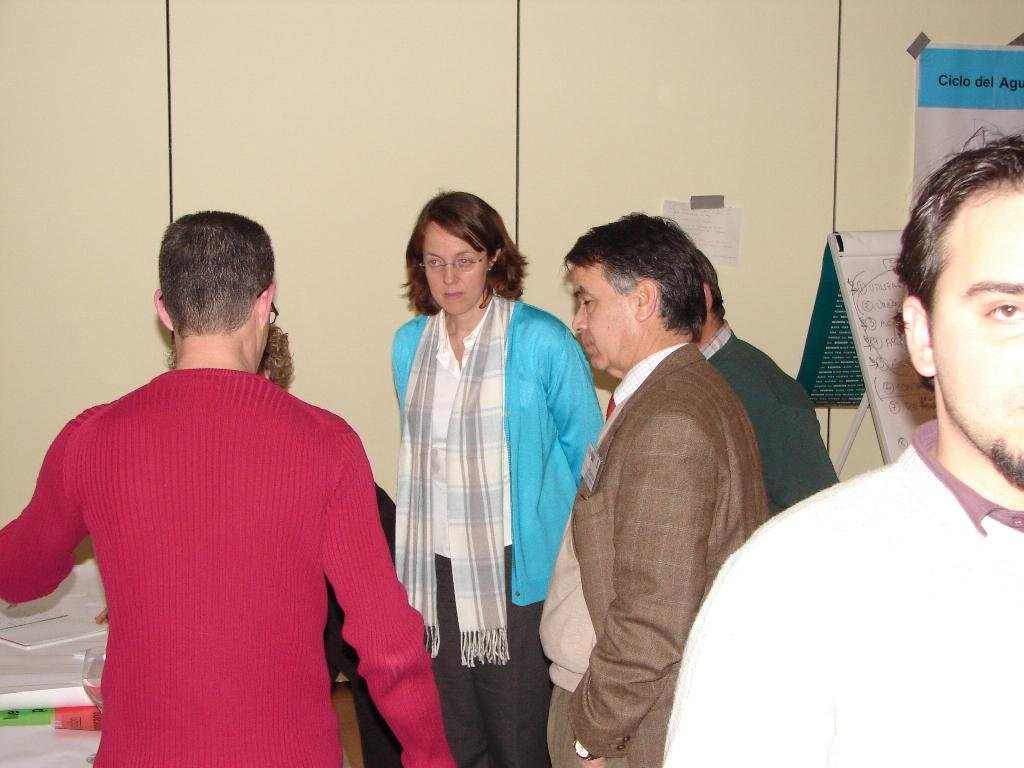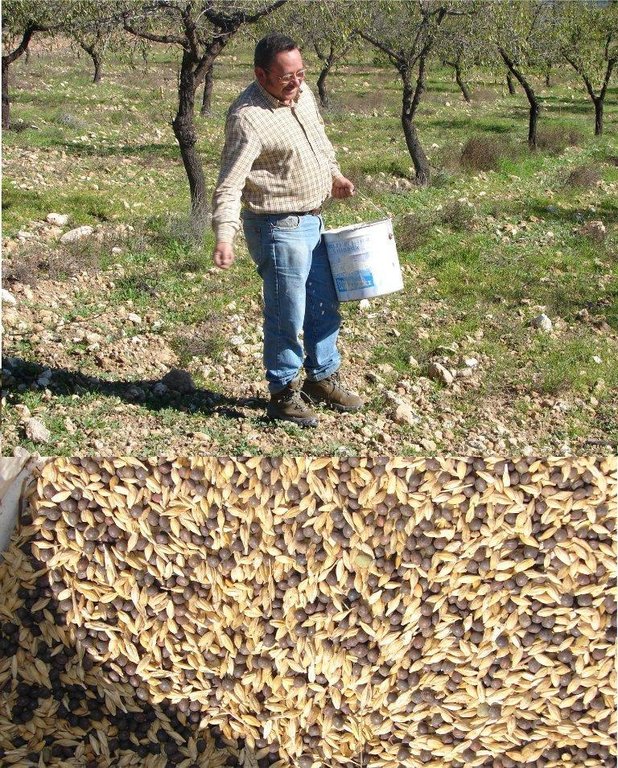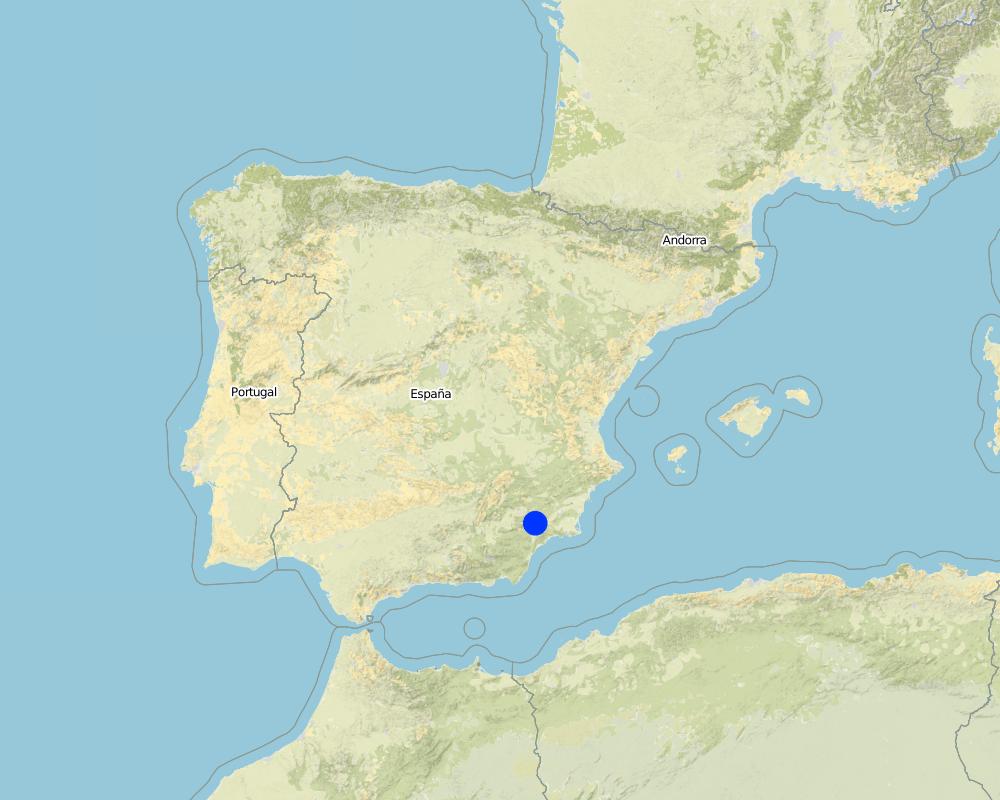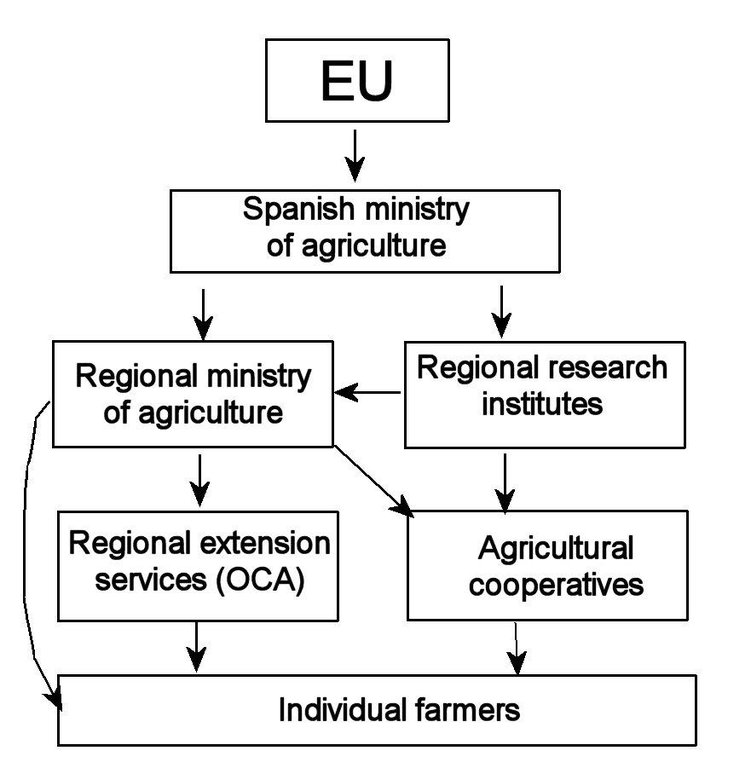Regional rural development programme [西班牙]
- 创建:
- 更新:
- 编制者: Joris De Vente
- 编辑者: –
- 审查者: David Streiff, Deborah Niggli
Programa de desarrollo rural de la región de Murcia (Spanish)
approaches_2419 - 西班牙
查看章节
全部展开 全部收起1. 一般信息
1.2 参与方法评估和文件编制的资源人员和机构的联系方式
SLM专业人员:
有助于对方法进行记录/评估的项目名称(如相关)
DESIRE (EU-DES!RE)有助于对方法进行记录/评估的机构名称(如相关)
EEZA-CSIC (EEZA-CSIC) - 西班牙1.3 关于使用通过WOCAT记录的数据的条件
编制者和关键资源人员接受有关使用通过WOCAT记录数据的条件。:
是
1.4 SLM技术问卷的参考
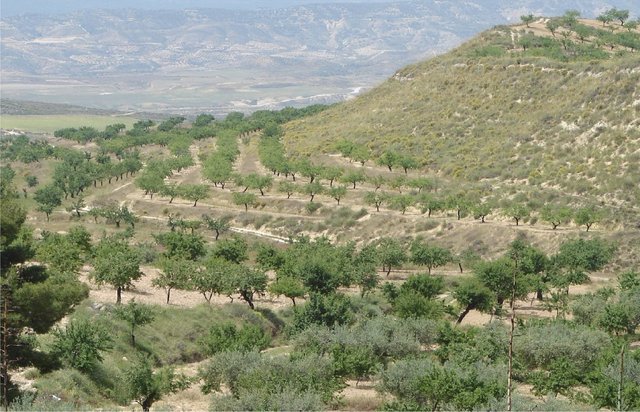
Vegetated earth-banked terraces [西班牙]
Earth-banked terraces in cereal and almond cropland covered with drought-resistant shrubs.
- 编制者: Joris De Vente
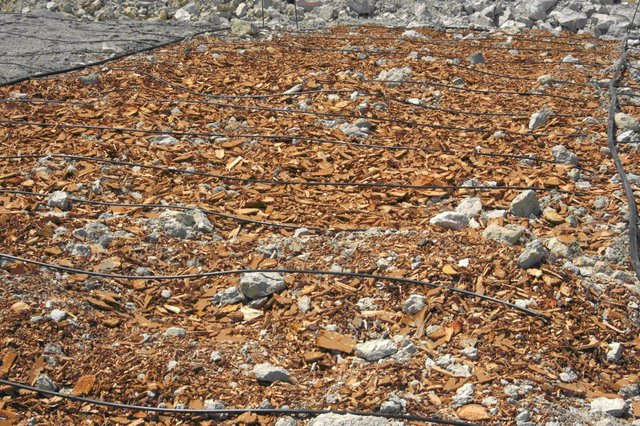
Organic mulch under almond trees [西班牙]
Organic mulching to protect against rain-splash, sheet wash and rill formation, reduce evaporation losses and weed growth.
- 编制者: Joris De Vente
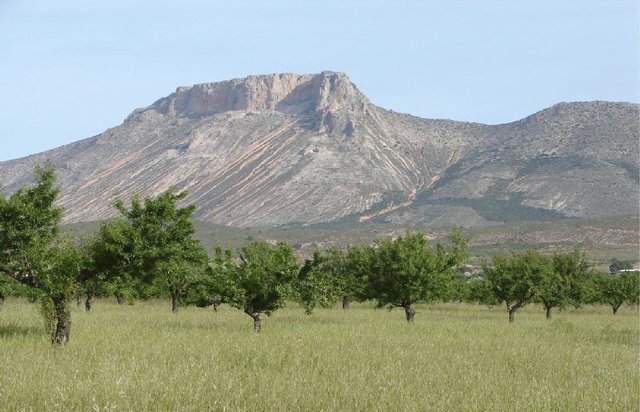
Ecological production of almonds and olives using green … [西班牙]
Ecological production of almonds and olives under dryland conditions using green manure to increase soil fertility, to protect against soil erosion and to obtain a high-value product.
- 编制者: Joris De Vente
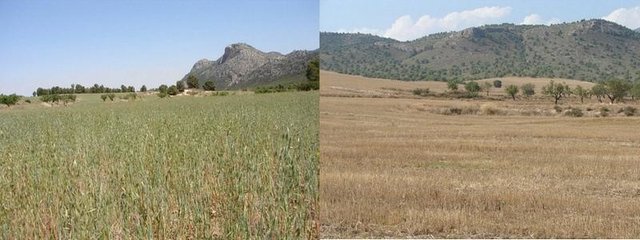
Reduced contour tillage of cereals in semi-arid environments [西班牙]
Reduced contour tillage in a rotational system of winter cereals and fallow land.
- 编制者: Joris De Vente
2. SLM方法的描述
2.1 该方法的简要说明
Regional development programme to protect natural resources and stimulate rural economies.
2.2 该方法的详细说明
该方法的详细说明:
Aims / objectives: The objective of the Rural Development Programme (RDP) is to assist farmers who have to deal with difficult environmental conditions (drought, steep slopes) to apply sustainable farming practices either in the implementation phase or for maintenance. The programme is carried out to: 1) improve the socio-economic conditions of rural areas; 2) prevent land abandonment, and 3) prevent on-site and off-site damages caused by land degradation and erosion. To achieve these objectives, the RDP identifies different lines of action: 1) compensate for difficult natural conditions; 2) fight against erosion; 3) reduce farming intensity; and 4) promote ecological agriculture.
Methods: The main method used in the RDP is through subsidies of farming practices following a cross-compliance principle. Each line of action implies a combination of conservation measures that are subsidised, but only when applied in combination. Hence, single conservation measures outside of these lines of action are not subsidies.
Role of stakeholders: The level of the subsidy is based on estimated implementation and maintenance costs and possible loss of productivity caused by the conservation measures. These values were obtained after consultation of various stakeholder groups including farmer organisations with agricultural cooperatives. However, because of limited resources, not all farmers will receive subsidies for the conservation measures. Priority is given to: 1) farmers who have 50% of their land within the Nature 2000 network, a European wide network of protected areas for the preservation of habitats and threatened species; 2) farmers with >50% of their land in unfavourable zones; and 3) farmers who did not receive subsidy in previous RDPs.
Other important information: Furthermore, areas with slopes of more than 20% are not subsidised in this programme since it is recommended that no agriculture takes place in these areas. Instead, reforestation of these areas is subsidised. RDPs are developed for a period of 7 years. Every seven years, a new RDP is defined and priorities and levels of subsidies can change. The present RDP is valid for the period 2007-2013.
2.3 该方法的照片
2.5 采用该方法的国家/地区/地点
国家:
西班牙
区域/州/省:
Murcia
有关地点的进一步说明:
Guadalentín basin, Spain
Map
×2.6 该方法的开始和终止日期
注明开始年份:
2007
2.7 方法的类型
- 基于项目/方案
2.8 该方法的主要目的/目标
The Approach focused mainly on SLM with other activities (Socio-economic development of rural areas)
1) improve the socio-economic situation of rural areas; 2) prevent land abandonment; and 3) prevent on-site and off-site damage caused by land degradation and erosion.
The SLM Approach addressed the following problems: The main problems addressed by the approach are low income and low productivity of farmers in rural areas, subsequent land abandonment, and erosion and land degradation processes causing on-site and off-site damage.
2.9 推动或妨碍实施本办法所适用的技术的条件
社会/文化/宗教规范和价值观
- 阻碍
The problem is not always recognised by everyone and certain practices are cultural.
Treatment through the SLM Approach: Information and training by the regional extension services and the agricultural organisations.
财务资源和服务的可用性/可得性
- 阻碍
Many technologies require an investment and maintenance, or even reduce productivity because they occupy land
Treatment through the SLM Approach: A subsidy equal to the loss of productivity and implementation and maintenance costs.
了解SLM,获得技术支持
- 阻碍
Some technologies require establishment of vegetation cover, which is difficult under arid conditions.
Treatment through the SLM Approach: Advice about which vegetation types to use and subsidy to cover the implementation costs.
3. 相关利益相关者的参与和角色
3.1 该方法涉及的利益相关者及其职责
- 当地土地使用者/当地社区
Farmer organisations (agricultural cooperatives)
Traditionally land users and agricultural activities are dominated by men
The focus of the approach is on the socioeconomic situation of farmers with a relatively low income and under marginal conditions.
- SLM专家/农业顾问
Research institutes
- 地方政府
regional ministry of agriculture
- 国家政府(规划者、决策者)
Part of the subsidies are paid directly by the national government
- 国际组织
Part of the subsidies are paid through the EU feader programm
3.2 当地土地使用者/当地社区参与该方法的不同阶段
| 当地土地使用者/当地社区的参与 | 指定参与人员并描述活动 | |
|---|---|---|
| 启动/动机 | 自我动员 | Petitions towards policy makers and farmers organizations to pay attention for production under difficult environmental conditions |
| 计划 | 互动 | Land users were sporadically consulted through farmers organizations and participated in protest meetings against initial versions of the RDP that they considered insufficient regarding payments for the agricultural sector |
| 实施 | 互动 | Land users implemented SLM technologies themselves with help from technicians of regional government and farmers organisations |
| 监测/评估 | 无 | |
| Research | 无 |
3.3 流程图(如可用)
具体说明:
To be fit for purpose, since 2007 the RDPs are designed at the regional level using advice from scientific institutes. The boundary conditions regarding the overall environmental and economic objectives and available finances are received from the European and national level. The regional extension services have a role in the dissemination of information and control of correct implementation of measures by farmers.
3.4 有关SLM技术选择的决策
具体说明谁有权决定选择要实施的技术:
- 主要是SLM专家,咨询土地使用者之后
解释:
Decisions were made in the regional ministry of agriculture after consultation of researchers and farmer organisations.
Decisions on the method of implementing the SLM Technology were made by by politicians / leaders. Politicians have decided the way of subsidising.
4. 技术支持、能力建设和知识管理
4.1 能力建设/培训
是否为土地使用者/其他利益相关者提供培训?:
是
明确受训人员:
- 现场工作人员/顾问
培训形式:
- 在职
- 农民对农民
涵盖的主题:
The technical conditions needed for control were explained to technicians. Training to land users was not provided directly, though advice can be obtained through agricultural organisations and extension services.
4.2 咨询服务
土地使用者有权使用咨询服务吗?:
是
指明是否提供了咨询服务:
- 在土地使用者的土地上
说明/注释:
Agricultural extension services (Oficina Comarcal Agrari; Key elements: advice, control
Advisory service is inadequate to ensure the continuation of land conservation activities; There is more information and awareness building required for land users. Information is often only available at political/research level and the level of the agricultural cooperatives but not at farm level.
4.3 机构强化(组织发展)
是否通过这种方法建立或加强了机构?:
- 是,少许
具体说明机构的强化或建立程度:
- 本地
具体说明支持类型:
- 能力建设/培训
提供进一步细节:
Information to agricultural cooperatives
4.4 监测和评估
监测和评估是该方法的一部分吗?:
是
注释:
bio-physical aspects were ad hoc monitored by government through measurements; indicators: farm visits, sampling of soils for chemical parameters
technical aspects were ad hoc monitored by government through measurements; indicators: farm visits to control the actual implementation of SLM measures
economic / production aspects were ad hoc monitored by land users through measurements; indicators: comparing production between years
area treated aspects were regular monitored by government through observations; indicators: farm visits and mapping with GIS tools
no. of land users involved aspects were regular monitored by government through observations; indicators: documentation of all farmers who participate in the subsidy programme
There were several changes in the Approach as a result of monitoring and evaluation: RDP's are evaluated and redefined every 7 years.
There were several changes in the Technology as a result of monitoring and evaluation: RDP's are evaluated and redefined every 7 years.
4.5 研究
研究是该方法的一部分吗?
是
明确话题:
- 经济/市场营销
- 生态学
- 技术
- geography
提供进一步的细节,并指出是谁做的研究:
Results from national and international research projects of the last decades were used as well as experimental results from regional and national research institutes like the IMIDA and CSIC.
Research was carried out both on station and on-farm
5. 融资和外部物质支持
5.1 该方法中SLM组成部分的年度预算
如果不知道准确的年度预算,请给出一个范围:
- > 1,000,000
注释(例如主要的资助来源/主要捐助者):
Approach costs were met by the following donors: international (EU FEADER programme): 41.0%; government: 10.0%; local government (district, county, municipality, village etc): 49.0%
5.2 为土地使用者提供财政/物质支援
土地使用者是否获得实施该技术的财政/物质支持?:
是
如果是,请具体说明支持的类型、条件和提供者:
Subsidies are provided by the regional ministry, state and EU programmes.
5.3 对特定投入的补贴(包括劳动力)
- 农业
| 具体说明哪些投入得到了补贴 | 程度如何 | 对补贴做出具体说明 |
|---|---|---|
| 种子 | 部分融资 | |
| 化肥 | 充分融资 | |
- 建筑
| 具体说明哪些投入得到了补贴 | 程度如何 | 对补贴做出具体说明 |
|---|---|---|
| 石料 | 充分融资 | |
- 其它
| 其它(具体说明) | 程度如何 | 对补贴做出具体说明 |
|---|---|---|
| productivity loss | 充分融资 |
5.4 信用
是否根据SLM活动的方法给予信用值?:
否
6. 影响分析和结论性陈述
6.1 方法的影响
该方法是否帮助土地使用者实施和维护SLM技术?:
- 否
- 是,很少
- 是,中等
- 是,支持力度很大
Awareness and motivation to apply SLM amongst land users has increased due to the approach.
该方法是否有助于社会和经济弱势群体?:
- 否
- 是,很少
- 是,中等
- 是,支持力度很大
Because of the approach the economic situation of farmers in marginal areas is slightly improved.
Did other land users / projects adopt the Approach?
- 否
- 是,很少
- 是,中等
- 是,支持力度很大
RDPs are developed for all regions in Spain, and need approval from national government and from the EU.
Did the Approach lead to improved livelihoods / human well-being?
- 否
- 是,很少
- 是,中等
- 是,支持力度很大
Because of the approach the economic situation of farmers is slightly improved.
Did the Approach help to alleviate poverty?
- 否
- 是,很少
- 是,中等
- 是,支持力度很大
Because of the approach the economic situation of farmers in marginal areas is slightly improved.
6.2 土地使用者实施SLM的主要动机
- 支付/补贴
- 规章制度(罚款)/执行
- 环境意识
6.3 方法活动的可持续性
土地使用者能否维持通过该方法实施的措施(无外部支持的情况下)?:
- 不确定
若否或不确定,请具体说明并予以注释:
Some of the technologies under the support do not have a high cost (e.g. reduced tillage and ecological agriculture). These can be continued without problems. Other technologies can be more problematic, for example the maintenance of vegetated earthen terraces can be too costly.
6.4 该方法的长处/优点
| 土地使用者眼中的长处/优势/机会 |
|---|
| All implementation and maintenance costs as well as loss of productivity are subsidised (How to sustain/ enhance this strength: There should be enough funding for all farmers willing to apply the measures, and there should be continuity across RDP’s.) |
| 编制者或其他关键资源人员认为的长处/优势/机会 |
|---|
| The approach is an effort to provide an integrated way of how SLM can be achieved. So no separate measures but a complete SLM plan at the farm level. (How to sustain/ enhance this strength: Including more measures in the approach.) |
6.5 该方法的弱点/缺点以及克服它们的方法
| 土地使用者认为的弱点/缺点/风险 | 如何克服它们? |
|---|---|
| There is a lack of organisation amongst land users | Agricultural cooperatives and regional extension services should have a more active role to coordinate activities and communication. |
| 编制者或其他关键资源人员认为的弱点/缺点/风险 | 如何克服它们? |
|---|---|
| There is a strong lack of land users participation in the design, implementation and training of the approach | Organise stakeholder meetings, information sessions and trainings for land users. |
| There is a lack of transparency in communication | Agricultural cooperatives and regional extension services should have a more active role to coordinate activities and communication. |
7. 参考和链接
7.1 方法/信息来源
- 实地考察、实地调查
链接和模块
全部展开 全部收起链接

Vegetated earth-banked terraces [西班牙]
Earth-banked terraces in cereal and almond cropland covered with drought-resistant shrubs.
- 编制者: Joris De Vente

Organic mulch under almond trees [西班牙]
Organic mulching to protect against rain-splash, sheet wash and rill formation, reduce evaporation losses and weed growth.
- 编制者: Joris De Vente

Ecological production of almonds and olives using green … [西班牙]
Ecological production of almonds and olives under dryland conditions using green manure to increase soil fertility, to protect against soil erosion and to obtain a high-value product.
- 编制者: Joris De Vente

Reduced contour tillage of cereals in semi-arid environments [西班牙]
Reduced contour tillage in a rotational system of winter cereals and fallow land.
- 编制者: Joris De Vente
模块
无模块


